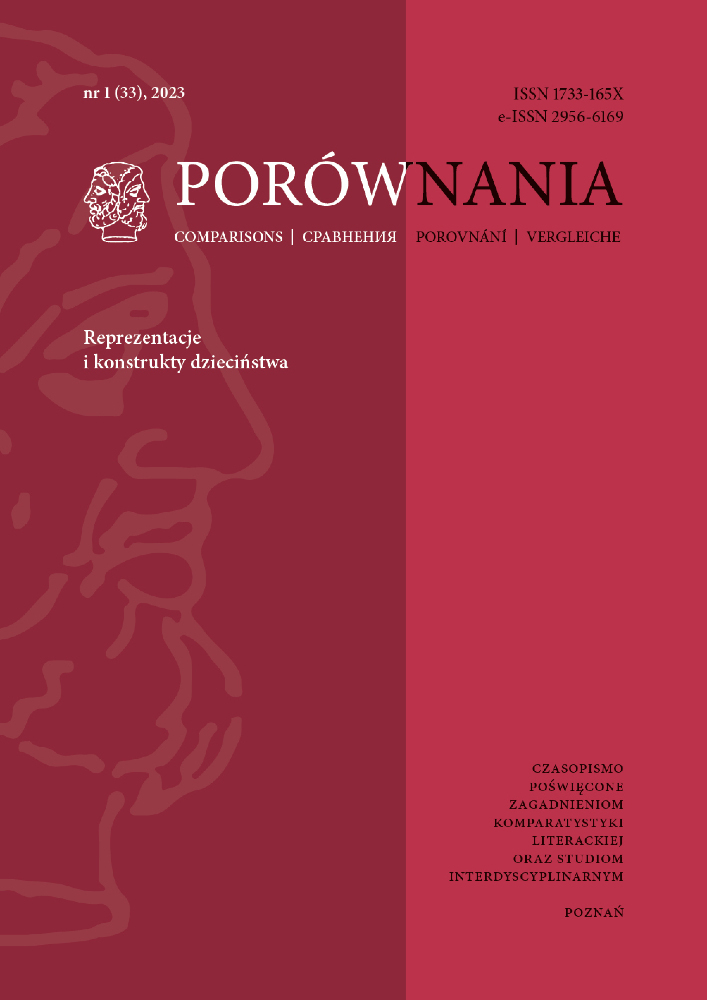Abstract
The paper seeks to establish the basis of the Polish translation of the Old French romance about the “beautiful Magielona.” The Polish version was translated in the sixteeth century, though not from the French, but via a German or Czech version. Until now, there were no studies on the base text of the Polish translation, transmitted in several seventeenth-century editions. The analysis presented in our paper concerns the delimitation of the text, i.e. the division of content into chapters in the Polish prints in comparison to the German editions of the sixteenth century and to the Czech version (transmitted from the eighteenth century), as well as the comparison of the opening sentences of the chapters. It allows for the conclusion that the Polish translation arose most probably from the German version, from an edition containing the primary segmentation of the German text, which in the second half of the sixteenth century was published in a secondary edition with a finer segmentation of the text.
References
ARLIMA: Les Archives de littérature du Moyen Âge, https://tinyurl.com/yck72c49, [dostęp: 30.06.2022.].
Biedermann Adolphe (1913), Préface, w: La belle Maguelonne, wyd. Adolphe Biedermann, Honoré Champion, Paris; Max Niemeyer, Halle, s. V–VIII.
Bolte Johannes, wyd. (1894), Die schöne Magelone, aus dem Französischen übersetzt von Veit Warbeck 1527, nach der Originalhandschrift, Verlag von Emil Felber, Weimar.
Brückner Aleksander (1901), Dawne powieści i romanse polskie, „Biblioteka Warszawska”, t. 2, z. 1, s. 506–544.
Chmiel Adam (1928), Inwentarz rzeczy introligatora Macieja Przywilckiego z 1587 r., b.w., Kraków [nadbitka z: „Silva Rerum” 1928, z. 4, s. 175–180].
Colliot Régine, wyd. (1977), L’ystoire du vaillant chevalier Pierre filz du conte de Provence et de la belle Maguelonne: texte du manuscrit S IV 2 de la Landesbibliothek de Cobourg, XVème siècle, CUER MA, Aix-en-Provence; Diffusion H. Champion, Paris.
Gotzkowsky Bodo (1991), „Volksbücher”: Prosaromane, Renaissancenovellen, Versdichtungen und Schwankbücher. Bibliographie der deutschen Drucke, t. 1: Drucke des 15. und 16. Jahrhunderts, Verlag Koerner, Baden-Baden.
Grześkowiak Radosław, Kizik Edmund (2005), Komentarz edytorski, w: Sowiźrzał krotochwilny i śmieszny. Krytyczna edycja staropolskiego przekładu Ulenspiegla, wyd. Radosław Grześkowiak, Edmund Kizik, Wydawnictwo Uniwersytetu Gdańskiego, Gdańsk, s. XLI–CXXIV.
[Historia o Magielonie, królewnie neapolitańskiej], [druga połowa XVII wieku], b.w., b.m., Biblioteka Jagiellońska, sygn. 586036 I.
Historia o Magielonie, królewnie neapolitańskiej (1677), b.w., Kraków, Centralna Biblioteka Naukowa Charkowskiego Uniwersytetu Narodowego, sygn. 196692.
Jaglarz Monika (2004), Księgarstwo krakowskie XVI wieku, Towarzystwo Miłośników Historii i Zabytków Krakowa, Kraków.
Jungmann Josef (1849), Historie literatury české. Aneb Soustavný přehled spisů českých s krátkou historií národu, osvícení a jazyka, České museum, Praha.
Knihopis: KPS Databáze Knihopis, http://www.knihopis.cz/ [dostęp: 30.06.2022.].
Krzywy Roman (2015), Zasady wydania, w: Historia o szlachetnej a pięknej Meluzynie, wyd. Roman Krzywy, Wydawnictwo Sub Lupa, Warszawa, s. 34–41.
Krzyżanowski Julian (1962), Romans polski wieku XVI, PIW, Warszawa [1. wyd. 1934].
Kuźmina Wiera (1962), Polska wersja „Historii o Magelonie”, jej przekład ukraiński i rosyjski z XVII wieku, „Slavia Orientalis”, t. XI/3, s. 323–350.
Kuźmina Wiera (1964), Rycarskij roman na Rusi. Bowa, Piotr Złatych Kluczej, „Nauka”, Moskwa.
Łoziński Władysław (1890), Leopolitana, „Kwartalnik Historyczny”, t. 4, s. 437–457.
Mika Tomasz (2015), Problemy z Rozmyślaniem przemyskim. Formułowanie sądów ogólnych a wielowarstwowość średniowiecznego tekstu, „LingVaria”, nr specjalny, s. 87–104. DOI: https://doi.org/10.12797/LV.10.2015.1SP.08
Müller Jan-Dirk (1990), Magelone, w: Romane des 15. und 16. Jahrhunderts. Nach den Erstdrucken mit sämtlichen Holzschnitten, wyd. Jan-Dirk Müller, Deutscher Klassiker Verlag, Frankfurt/Main, s.1226–1239.
Putzo Christine (2019), Pierre und Maguelonne in Sachsen. Die Rezeption der Belle Maguelonne am kurfürstlichen Hof und Veit Warbecks deutsche Fassung (1527), w: Romania und Germania. Kulturelle und literarische Austauschprozesse in Spätmittelalter und Früher Neuzeit, red. Bernd Bastert, Sieglinde Hartmann, Reichert Verlag, Wiesbaden, s. 224–250.
Rudnicka Jadwiga (1964), Bibliografia powieści polskiej 1601–1800, Zakład Narodowy im. Ossolińskich, Wrocław.
Schmidt Imke (1996), Die Bücher aus der Frankfurter Offizin Gülfferich – Han – Weigand Han-Erben. Eine literarhistorische und buchgeschichtliche Untersuchung zum Buchdruck in der zweiten Hälfte des 16. Jahrhunderts, Harrassowitz, Wiesbaden.
Simmler Franz (1983), Syntaktische Strukturen im Prosaroman des 16. Jahrhunderts. Die Schoen Magelona, „Sprachwissenschaft”, nr 8, s.137–187.
Stich Alexandr, Kolár Jaroslav (2000), Komentář, w: Tři knížky lidového čtení. Meluzína, Magelona, Jenovefa, wyd. Jaroslav Kolár, Lidové noviny, Praha, s. 255–305.
Striedter Jurij (1960), Der polnische „Fortunatus” und seine deutsche Vorlage, „Zeitschrift für Slavische Philologie”, t. 29, nr 1, s. 32–91.
Voit Petr (1987), Moravské prameny z let 1567–1568 k dějinám bibliografie, cenzury, knihtisku a literární historie. Příspěvky ke knihopisu 5, SK ČSR, Praha.
Voit Petr (2017), Český knihtisk mezi pozdní gotikou a renesancí II. Tiskaři pro víru i tiskaři pro obrození národa, Academia, Praha.
License
Copyright (c) 2022 Krystyna Wierzbicka-Trwoga

This work is licensed under a Creative Commons Attribution-NoDerivatives 4.0 International License.
Utwory opublikowane w czasopiśmie „Porównania”, na platformie Pressto należącej do Uniwersytetu im. Adama Mickiewicza w Poznaniu są udostępniane na licencji Creative Commons Uznanie autorstwa - Bez utworów zależnych 4.0 Międzynarodowe (CC BY-ND 4.0)
Tym samym wszyscy zainteresowani są uprawnieni do korzystania z utworów opublikowanych pod następującymi warunkami:
-
uznania autorstwa — czyli obowiązek podania wraz z rozpowszechnianym utworem informacji o autorstwie, tytule, źródle (odnośniki do oryginalnego utworu, doi) oraz samej licencji
-
bez utworów zależnych — remiksując, przetwarzając lub tworząc na podstawie utworu, nie wolno rozpowszechniać zmodyfikowanych treści.
-
brak dodatkowych ograniczeń — nie można korzystać ze środków prawnych lub technologicznych, które ograniczają innych w korzystaniu z utworu na warunkach określonych w licencji.
Uniwersytet im. Adama Mickiewicza w Poznaniu zachowuje prawo do czasopisma jako całości (układ, forma graficzna, tytuł, projekt okładki, logo itp.).
Autor zachowuje prawa majątkowe, ale udziela zgody Uniwersytetowi im. Adama Mickiewicza w Poznaniu na wykorzystanie dzieła. Autorzy tekstów zakwalifikowanych do publikacji proszeni są o wypełnienie podpisanie i przesłanie umowa (PL) agreement (EN)
Agreement for granting a royalty-free license to works with a commitment to grant a CC sub-license





